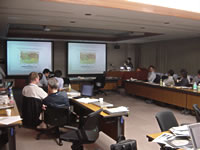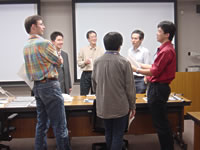 |
|||||||
| In the summer of 2007, when the temperature will probably be 40 degrees Celsius, the Hayabusa re-entry capsule is scheduled to land in a desert in Australia with samples of an asteroid to complete its mission. All we can expect at the end of the mission is the reentry capsule, which is 40 to 50 cm in size, after a four year trip far away. Still, it is an extraordinary achievement that we can expect something to come back from an asteroid exploration mission. In September 2005, the asteroid explorer "Hayabusa", which is not huge in size and deliberately unconventional in shape, arrived at the asteroid "Itokawa", which is 320 million km away from the earth (this distance is more than the round trip mileage between the Earth and the Sun.) The Hayabusa is about to carry out the big challenge of acquiring the first samples ever taken from an asteroid. The mission is now at a climax, even though it is still at the middle of its final goal. The Hayabusa operation room at JAXA Sagamihara Campus (the Institute of Space and Astronautical Science) is a small window to deep space and asteroids where mankind has never traveled before. We would like to report mission topics and helpful information to help you understand the Hayabusa mission from the operation room, which is now in a tense atmosphere.
(Junya Terazono, JAXA Website editor and a member of the Hayabusa operation team)
[From Nov. 17, 2005] |
|||||||

 One day in late October, the "Sample Site Selection Meeting (SSS Meeting)" was held for the Hayabusa mission at Sagamihara Campus. The meeting was held to select the site where the Hayabusa will take samples. In other words, we selected "where we will make Hayabusa touch down." One day in late October, the "Sample Site Selection Meeting (SSS Meeting)" was held for the Hayabusa mission at Sagamihara Campus. The meeting was held to select the site where the Hayabusa will take samples. In other words, we selected "where we will make Hayabusa touch down." First of all, it has to be the best site to achieve scientific results, in addition to being a safe place. Thus we have to select a safe touch down target point that will not impact the mission operation and also have maximum scientific significance. In the meeting, Japanese and American scientists got together and held a heated debate, and that told us a different aspect of this meeting. (American scientists are also members of the project.) To decide the best site, the participants have to exchange opinions based on not only detailed mission information but also cutting-edge scientific knowledge. Consequently, this meeting became a very heated workshop on the most advanced asteroid science.  New data from the Hayabusa were revealed, and the scientists were thrilled by vivid images of the Itokawa. In some cases, even the presenter was a bit confused about which side was the correct upside as the images were very new. Thus he turned them around and around for a while. (The coordination, longitude and latitude of the Itokawa have already been determined, so there is no problem in selecting the sample site.) New data from the Hayabusa were revealed, and the scientists were thrilled by vivid images of the Itokawa. In some cases, even the presenter was a bit confused about which side was the correct upside as the images were very new. Thus he turned them around and around for a while. (The coordination, longitude and latitude of the Itokawa have already been determined, so there is no problem in selecting the sample site.) Photo: SSS Meeting The achievements of each onboard observation equipment were reported, and site selection was discussed. The meeting was in English, and, in some cases, Japanese scientists asked and answered questions among themselves. Photo: Joking in English during a break. »Story 2: Invitation to asteroid science started in the 19th Century |
|
||||||
|
|||||||